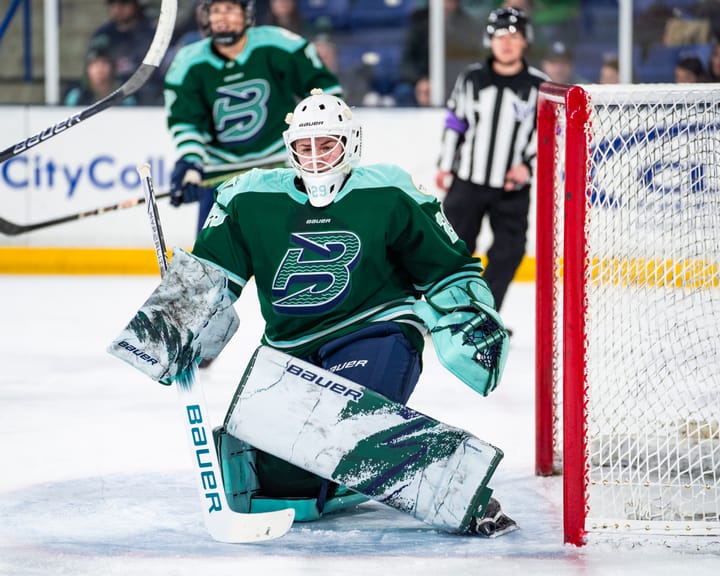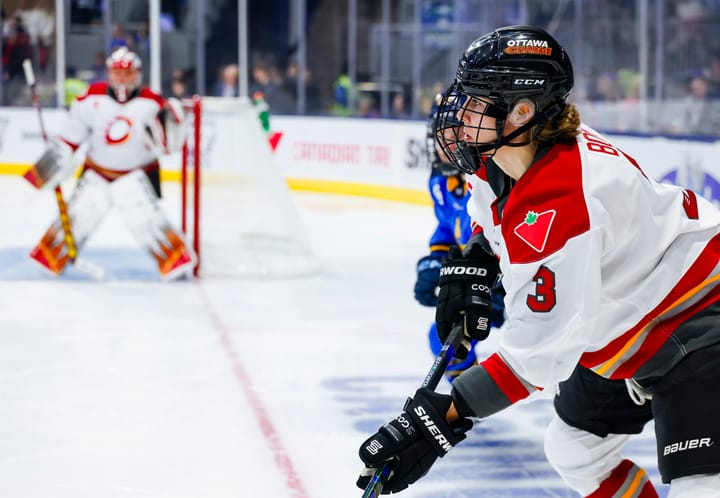Takeaways from the PHF’s 2022-23 by-laws
The PHF announced publication of its new by-laws late last week, in a first for the league as it approaches Year Eight. More than a few fans and media members hailed this as a step forward for transparency when it comes to the Fed and its practices, and some of the by-laws’ wording indicates we’re going to see some shifts in the system as time goes on.
The PHF today announced another step forward in the growth and development of the league and its commitment to transparency with the full publication of the 2022-23 PHF Bylaws
— PHF (@PHF) September 2, 2022
Details https://t.co/BG4l9z9FDh pic.twitter.com/3RcFRneITc
Here’s what stuck out to me the most when reading through the text:
Registration age lowered to 18: pros and cons
One of the very first differences I spotted was the PHF lowering its eligibility age from “having completed collegiate play” (typically around 21-22) to 18.
Any player who attains the age of 18 prior to the commencement of the PHF season that (i) has not previously participated in, or has not elected to participate in collegiate athletics, or (ii) has forfeited (due to injury, leave of absence, collegiate retirement, etc.) their collegiate eligibility, provided that such player registration and eligibility shall be subject to review and approval by the Commissioner and the Board of Governors, with such approval not to be unreasonably withheld or delayed.
This allows high school grads to participate for the first time ever, very similarly to the NHL and (to a lesser extent) boys’ junior hockey structure.
On one hand, this can really benefit some players who may not be willing or able to take the college route, but still want to play. It can also open the door for more and younger international players to sign with the PHF either on a PTO basis or even for a full season, whether that’s to get more experience for their own national teams or just to gauge where they’re at compared to pro athletes in North America.
On the other side, of course there’s a concern some players might postpone their education prematurely in order to achieve their full potential in the world of professional hockey; however, I really don’t know how many will take that route, especially considering the relative instability still surrounding North American pro women’s hockey. Having a backup career option is still a reality for so many of these players, at least until we can get the Fed or any subsequent league to a stage where they truly can flourish as athletes only.
Free agency gets a little more structured
For the first time, we’re getting RFA. The PHF is implementing a 45-day restricted free agency period to begin at the end of the season, during which teams can re-sign rostered players without interference from other teams. Once that time is up, unrestricted free agency will begin, allowing players to switch teams if desired. I’m excited for this because it will make it a bit easier to track who’s staying and who has the potential to leave at the end of each year, on each team. Given the relative chaos of our first-ever free agency with a doubled salary cap this year, I’m down for a little more predictability.
As was the case this past offseason, I don’t think we can expect a player draft next spring, which is a bit disappointing. I think the draft is a key part of the league’s success, not just in terms of building connections with USPORTS and the NCAA, but also in terms of drumming up fanfare and marketing tactics to promote the league. I understand the desire to maximize players’ freedom of choice, but having that extra event would just add a lot of legitimacy, in my opinion.
PTOs, practice players, and the numbers surrounding them
We also have a lot clearer information when it comes to PTOs, which have long existed in a nebulous capacity within the PHF. Each team is given a maximum of 10 PTO agreements to sign players to during the regular season, consisting of one game per contract. The same player can be signed to multiple agreements during the course of the season, with each new PTO counting toward the overall maximum. Players signed to a PTO will receive $375 per game played, but there is still no word on whether any merch generated from a jersey or shirsey with said player’s name on it would entitle them to the 15% share signed players receive from merch sales (Tsubasa Sato’s PTO with the Whale last season would be an example of this).
One would hope if a team put forth the effort to make merch for that player, even on a limited basis, they would also be able to give that player a portion of the proceeds. After all, they’re making money off of the player’s name, quite literally. The lack of information around this is likely due to the fact that it doesn’t happen that often, but I’d personally love some clarity regarding it.
The same goes for any practice player, who will operate on an “independent contractor” basis with a PHF team and is to receive $150 per week for participation in practices and other team activities (likely meet and greets or clinics). These players are making a bigger commitment, essentially, but they are not entitled to any of the medical benefits signed players receive from the league.
This is the first we’ve really heard of any actual structure to the practice player situation, which is refreshing and also eliminates any of the murkiness surrounding where a practice player fits into the roster. After all, I think we all can remember the way Kelley Steadman evolved basically into a rostered player after joining the Beauts on a practice player basis. That said, I would assume any practice player could thus be signed to a PTO and be eligible for a game, which can be beneficial for teams with lighter rosters who might suffer an injury. (Let’s just hope they have good health insurance.)
Exhibition games: league-scheduled vs. team-scheduled
Section 10.2 breaks down the scheduling and structure surrounding games outside of the regular PHF season. In addition to the annual All-Star Game, the Fed may schedule preseason or exhibition games; however, individual teams also reserve the right to schedule their own. Team-scheduled games are considered “voluntary” and will be unpaid, as stipulated in the section.
Interestingly, there is no clarification on whether league-scheduled exhibition games are also considered “voluntary” or whether players would be paid for those. There is similarly no information on whether, or how much, players would be paid for participation in the All-Star Game, outlined in Section 10.1. Obviously players can choose whether to take part and the extent of that participation, but it would still be nice to get a little more information on what kind of compensation they’d receive since it is another form of promotion for the PHF.
Long-Term Injury Reserve and more injury protocol
Section 4.6 states that in the event of a long-term injury to a player, a team can now place that player on LTIR for 21 days or longer. During that time, the team would in fact be able to sign another player to take her place. The confusion comes from exactly how the cap works in this instance.
In the event a PHF Team elects to designate a player to long term injury reserve, such PHF Team may enter into a standard player contract with an additional player, so long as such PHF Team remains in compliance with the then operative salary cap maximum, taking into account the addition of consideration payable to such incoming player and the subtraction of consideration payable to such player designated to long term injury reserve. For the avoidance of doubt, the roster freeze set forth in Section 4.5 shall not preclude any roster transactions described in this Section 4.6.
My best interpretation of this wording is that any team signing a player to replace someone on LTIR will need to keep that injured player’s salary in the back of their mind for cap reasons, because once that player is reactivated, a team could very well find themselves out of compliance. LTIR can provide cap relief, but will not completely factor out an injured player’s salary, much in the same way the NHL’s cap works. Pregnancy is also its own section, with players being placed on LTIR if they are expecting. There is, however, no set time limit on maternity leave in the PHF at this time.
Jumping to Section 11 regarding missed games and injuries, the Fed outlines that any player injured can be reimbursed for any out of pocket medical expenses (such as deductibles, co-pays, etc.) by their team, provided the medical providers used are team-approved. Exactly what that means remains a mystery — does that mean the team picks the provider, or simply that the provider should be in-network for the insurance the Fed pays for, or something else? I feel like that could be a slippery slope in the event of a more serious injury or a required surgery; for me, the Jack Eichel situation in the NHL immediately springs to mind. But I guess we won’t know until it happens, which is frustrating.
Relocation and living expenses
The Fed is also allowing teams to fund a player’s relocation if needed — with limitations. Any player making $30,000 or less is allotted up to $5,000 by the team to put toward moving and living expenses, with a cap of $10,000 team-wide. These amounts would not count toward the salary cap. So a player making league minimum of $13,500 could find herself being helped out if she’s making a cross-state or cross-border move, and that help wouldn’t hurt the cap any, which is nice.
Any player in excess of $30,000 is also entitled to this kind of assistance with no monetary limit; however, any money put forth by the team to help those players will count toward the salary cap, which to my thinking acts as a sort of “luxury tax” for those players with larger contracts.
Off-ice conduct a focus for the first time
I’ve covered this league basically from the beginning, and I’ve never heard or read a word about off-ice behavior until now. But that’s the entire focus of Section 13 of the by-laws, which states the Commissioner will reserve the right to suspend, fine, or even end the contract of any player she feels “has acted in a way that is detrimental to or against the welfare of the League or the game of hockey.” The same goes for coaches or any other member of team staff.
Now, we don’t know anything related to severity, number of incidences, or what fines or suspensions would in fact look like. But this is a pretty big step forward for the Fed when it comes to this sort of discipline. Obviously there have been some big instances in the past couple of years surrounding players’ activities on social media or otherwise, as well as whom they’ve chosen to interact with. While of course these players are adults and their own human beings, the fact that the PHF is starting to take this a bit more seriously is heartening.
Despite some of the confusion still surrounding some of the by-laws and their language, I think the fact that we have this made public for the first time is huge for making the Fed’s protocols and structure much more transparent. There’s still a ways to go, but I’m looking forward to what this means for the PHF not just for Year Eight, but beyond.





Comments ()